
TNU Journal of Science and Technology
230(02): 295 - 300
http://jst.tnu.edu.vn 295 Email: jst@tnu.edu.vn
EFFECTS OF HEAT TREATMENT ON THE CORROSION POTENTIAL
OF AISI 1040 STEEL IN THE SEAWATER
Nguyen Ngoc Minh, Nguyen Ngoc Lan*
School of Materials Science and Engineering - Hanoi University of Science and Technology
ARTICLE INFO
ABSTRACT
Received:
04/02/2025
Carbon steel is the most economical and widely used material in the
world because it has a low price and good quality. However, carbon
steel also has the disadvantage of being susceptible to corrosion,
especially in highly corrosive environments such as seawater. Steel can
be heat treated to slow down the destruction process and increase
corrosion resistance. In this study, the corrosion potential of steel was
evaluated based on heat-treated samples, including annealed,
normalized, quenched, and tempered samples working in seawater. The
results showed that the quenched sample obtained a solid solution
structure with the highest corrosion resistance compared to the
annealed and normalized samples. The corrosion potential of the
sample after quenching was achieved at -0.604 V, while the corrosion
potential of the samples after annealing and normalizing was -0.77 V
and -0.758 V, respectively. The tempering temperature also showed an
effect on the corrosion potential. In the tempering temperature range
from 200 oC to 500 oC, the corrosion potential value decreased from -
0.57 V to -0.64 V as the tempering temperature increased.
Revised:
28/02/2025
Published:
28/02/2025
KEYWORDS
Heat treatment
Corrosion behavior
AISI 1040
Corrosion potential
Carbon steel
ẢNH HƯỞNG CỦA CHẾ ĐỘ XỬ LÝ NHIỆT ĐẾN ĐIỆN THẾ ĂN MÕN
CỦA THÉP AISI 1040 TRONG MÔI TRƯỜNG NƯỚC BIỂN
Nguyễn Ngọc Minh, Nguyễn Ngọc Lan*
Trường Vật liệu - Đại học Bách khoa Hà Nội
THÔNG TIN BÀI BÁO
TÓM TẮT
Ngày nhận bài:
04/02/2025
Thép cácbon là loại vật liệu kinh tế và được sử dụng nhiều nhất trên thế
giới do nó có giá thành thấp và chất lượng tốt. Tuy nhiên, thép cácbon
cũng có nhược điểm là dễ bị ăn mòn, đặc biệt là những môi trường có
tính xâm thực mạnh như nước biển. Để làm chậm quá trình phá hủy,
thép có thể được mang đi xử lý nhiệt để tăng khả năng bền ăn mòn.
Trong nghiên cứu này, điện thế ăn mòn thép được thực hiện đánh giá
dựa trên các mẫu đã qua xử lý nhiệt bao gồm mẫu sau ủ, mẫu sau
thường hóa, mẫu sau tôi và ram làm việc trong môi trường nước biển.
Kết quả nghiên cứu đã chỉ ra rằng mẫu sau tôi nhận được tổ chức dung
dịch rắn cho khả năng bền ăn mòn cao nhất khi so sánh với mẫu sau ủ
và thường hóa. Điện thế ăn mòn của mẫu sau tôi đạt được tại -0,604 V
trong khi điện thế ăn mòn của các mẫu sau ủ và thường hóa lần lượt là -
0,77 V, -0,758 V. Nhiệt độ ram cũng đã cho thấy có ảnh hưởng đến
điện thế ăn mòn. Trong khoảng nhiệt độ ram từ 200 oC đến 500 oC, giá
trị điện thế ăn mòn giảm từ -0,57 V đến -0,64 V khi nhiệt độ ram tăng.
Ngày hoàn thiện:
28/02/2025
Ngày đăng:
28/02/2025
TỪ KHÓA
Xử lý nhiệt
Ứng xử ăn mòn
AISI 1040
Điện thế ăn mòn
Thép cácbon
DOI: https://doi.org/10.34238/tnu-jst.11958
* Corresponding author. Email: lan.nguyenngoc1@hust.edu.vn

TNU Journal of Science and Technology
230(02): 295 - 300
http://jst.tnu.edu.vn 296 Email: jst@tnu.edu.vn
1. Giới thiệu
Thép cácbon là hợp kim quan trọng được sử dụng rất nhiều trong các ngành công nghiệp như
dầu mỏ, hóa chất, xây dựng do độ bền phù hợp, khả năng hàn và tạo hình tốt [1], [2]. Tuy nhiên,
vật liệu này rất dễ bị ăn mòn khi sử dụng trong môi trường tự nhiên, đặc biệt là trong các môi
trường có tính xâm thực cao như nước biển [2] – [4]. Điều này sẽ dẫn đến tổn thất lớn về kinh tế
[5], [6]. Để giảm thiểu được thiệt hại do ăn mòn, có nhiều phương pháp có thể được sử dụng như
bảo vệ điện hóa, tạo lớp phủ bảo vệ, dùng chất ức chế ăn mòn hay xử lý nhiệt [7], [8]. Trong đó,
xử lý nhiệt là một phương pháp hiệu quả để làm thay đổi cấu trúc tế vi của thép, qua đó dẫn đến
kết quả là cải thiện được tính chất bao gồm cả việc làm tăng tính bền ăn mòn.
Xử lý nhiệt bao gồm các phương pháp như thường hóa, ủ, tôi và ram đều cho thấy có tác động
nhiều đến khả năng bền ăn mòn cho thép [5]. Với thép cácbon trung bình, nhiệt độ nung sẽ được
lựa chọn trên nhiệt độ Ac3 tương ứng với hàm lượng cácbon có trong thành phần. Quá trình giữ
nhiệt sau đó có tác dụng phân hủy các hợp chất như xêmentít, cácbít, v.v. để hòa tan và làm đồng
đều thành phần trong dung dịch rắn austenit trước khi làm nguội hợp lý sẽ nhận được tổ chức có
ảnh hưởng đến tính bền ăn mòn của thép. Đã có nhiều nghiên cứu chứng minh được tầm quan
trọng của quá trình nhiệt luyện đến việc cải thiện độ bền ăn mòn cho thép [9]. Tuy nhiên, với mỗi
mác thép có thành phần khác nhau, thông số cụ thể của quá trình nhiệt luyện cũng sẽ phải thay
đổi để tối ưu hóa được độ bền ăn mòn của thép. Do đó, việc nghiên cứu chi tiết để tìm ra được
thông số phù hợp ứng với từng thành phần đặc trưng là cần thiết.
Trong nghiên cứu này, thép AISI 1040 được mang đi ủ tại 840 oC, thường hóa tại 860 oC, tôi ở
860 oC và kết hợp ram trong khoảng nhiệt độ (200-500) oC. Các kết quả nghiên cứu đã cho thấy,
chế độ nhiệt luyện có ảnh hưởng đến tổ chức tế vi, qua đó ảnh hưởng đến độ bền ăn mòn của thép.
2. Thực nghiệm
Thực hiện nghiên cứu này, thép AISI 1040 sử dụng có thành phần hóa học được biểu diễn
trong Bảng 1.
B ng 1 Bảng thành phần hóa học của thép AISI 1040
Nguyên tố
C
Si
Mn
P
S
Fe
% Khối lượng
0,38
0,34
0,81
0,03
0,04
98,40
Để thực hiện được việc đánh giá về ảnh hưởng của chế độ nhiệt luyện đến tổ chức và tính bền
ăn mòn, thép được cắt thành các mẫu khối nhỏ có kích thước (15x10) mm. Tất cả các mẫu đều
được nung trong môi trường bảo vệ nhằm đảm bảo bề mặt mẫu không bị oxy hóa hay thoát
cácbon trong quá trình nung. Điều này giúp cho dữ liệu thu được khi quan sát có mức độ tin cậy
tốt hơn. Chế độ xử lý nhiệt theo đó được thực hiện bằng lò điện trở có điều khiển (Nabertherm,
model N11/H) như sau: mẫu ủ và thường hóa lần lượt được thực hiện tại các nhiệt độ theo thứ tự
840 oC và 860 oC. Với mẫu tôi, nhiệt độ tôi thực hiện tại 860 oC trước khi tiến hành ram tại các
nhiệt độ 200 oC, 300 oC, 400 oC và 500 oC trong thời gian 1 giờ.
Để quan sát và đánh giá được sự thay đổi trong cấu trúc, các mẫu khối sau nhiệt luyện được
cắt ngang, tiếp đó mài phẳng, đánh bóng và tẩm thực trước khi quan sát dưới kính hiển vi quang
học (Olympus GX53). Để xác định sự thay đổi cấu trúc trong quá trình ram, các mẫu được kiểm
tra cấu trúc bởi giản đồ nhiễu xạ tia X (XRD) trên thiết bị (XRD, ARL EQUINOX 5000). Các
mẫu đo điện thế ăn mòn trong môi trường nước biển (được lấy trực tiếp tại khu vực biển Cồn
Vành, Tiền Hải, Thái Bình) đều được làm sạch bề mặt và kiểm tra trên thiết bị đo thông số điện
hoá (PGSTAT302N). Giá trị được phân tích và ghi lại trên phần mềm điều khiển, việc tính toán
hoàn toàn tự động.

TNU Journal of Science and Technology
230(02): 295 - 300
http://jst.tnu.edu.vn 297 Email: jst@tnu.edu.vn
3. Kết qu và bàn luận
3.1. Kết quả quan sát trên kính hiển vi quang học
Hình ảnh tổ chức tế vi của các mẫu trên kính hiển vi quang học được thể hiện như trên Hình 1
và Hình 2. Với các mẫu sau ủ và thường hóa, tốc độ nguội khác nhau đã thể hiện rõ qua việc quan
sát kích thước các hạt tinh thể với cùng độ phóng đại. Mẫu ủ (Hình 1a), tốc độ nguội chậm cho
phép các hạt sát nhập làm tăng kích thước trong khi đối với mẫu thường hóa (Hình 1b), việc nguội
ngoài không khí tĩnh có tốc độ nguội cao hơn cho phép giữ được kích thước hạt nhỏ mịn hơn.
Hình 1 Ảnh tổ chức tế vi của các mẫu thép ở độ phóng đại ×500: (a) mẫu sau ủ; (b) mẫu sau thường hóa
Với các mẫu sau tôi và ram ở các nhiệt độ khác nhau, tổ chức mactensit nhỏ mịn khi ram ở
nhiệt độ thấp (Hình 2a) và hỗn hợp bao gồm cácbít và ferit khi ram ở nhiệt độ cao hơn (Hình
2b-d) như thể hiện trên Hình 2. Trên tất cả các mẫu sau ram đều quan sát thấy có sự tiết ra cácbít
là các hạt nhỏ màu sáng, và chúng có xu hướng tăng dần kích thước khi nhiệt độ ram tăng. Mặc
dù vậy, việc đánh giá này cũng chưa thực sự rõ ràng do hạn chế về mức độ phóng đại của kính
hiển vi quang học sử dụng.
Hình 2 Ảnh tổ chức tế vi của các mẫu thép sau tôi và ram ở các nhiệt độ khác nhau với độ phóng đại
×500: (a) sau ram tại 200 oC; (b) sau ram tại 300 oC; (c) sau ram tại 400 oC; (d) sau ram tại 500 oC
3.2. Kết quả XRD
Kết quả kiểm tra nhiễu xạ Rơn ghen đối với một số mẫu bao gồm: mẫu sau ủ, mẫu sau tôi và
mẫu sau tôi kết hợp ram, kết quả như thể hiện trên Hình 3. Các đỉnh nhiễu xạ chính lần lượt theo
thứ tự từ góc nhiễu xạ thấp lên cao được xác định là (110), (200) và (211). Đây chính là các đỉnh
nhiễu xạ đặc trưng của sắt alpha (Fe) [10]. Mặc dù vậy, trên tất cả các giản đồ XRD của mẫu sau
(a)
(b)
40 m
40 m
(a)
(b)
(d)
(c)
40 m
40 m
40 m
40 m

TNU Journal of Science and Technology
230(02): 295 - 300
http://jst.tnu.edu.vn 298 Email: jst@tnu.edu.vn
ram, vẫn không quan sát thấy có sự xuất hiện vạch nhiễu xạ đặc trưng của các pha cácbít tiết ra
trong quá trình ram. Điều này có thể do hàm lượng cácbít vẫn còn khá nhỏ nên tín hiệu rơn
ghen không đủ để xác nhận.
Với mẫu sau ủ (Hình 3a), kết quả XRD cũng đã phản ánh được tổ chức thép như khẳng định
trong phần kết quả khi quan sát dưới kính hiển vi quang học bao gồm chủ yếu là ferit. Với mẫu
sau tôi (Hình 3b), vị trí các vạch nhiễu xạ hơi dịch sang trái so với mẫu sau ủ. Nguyên nhân là do
trong quá trình tôi, việc nung trên nhiệt độ Ac3 giúp hòa tan nhiều vào trong nền austenit. Do đó
kết quả là làm tăng hằng số mạng tinh thể dẫn đến việc giảm góc nhiễu xạ 2.
Hình 3 Giản đồ nhiễu xạ tia X: (a) mẫu sau ủ; (b) mẫu sau tôi;
(c) mẫu sau tôi và ram ở 200 oC; (d) mẫu sau tôi và ram ở 500 oC
Với các mẫu sau ram (Hình 3c-d), vị trí các đỉnh nhiễu xạ chính trên giản đồ XRD so sánh với
của mẫu sau tôi thì lại có xu dịch chuyển dần sang phải (theo chiều tăng góc nhiễu xạ 2). Nhiệt
độ ram càng cao, mức độ dịch chuyển càng lớn. Nguyên nhân là do khi tăng nhiệt độ ram, các
nguyên tố hợp kim đang hòa tan trong mactensit có xu hướng di chuyển nhiều hơn ra khỏi nền.
Kết quả là làm giảm mức độ xô lệch mạng và giảm hằng số mạng tinh thể. Hệ quả là làm tăng
góc nhiễu xạ 2.
3.3. Kết quả thử điện thế ăn mòn
Ảnh hưởng của phương pháp nhiệt luyện đến điện thế ăn mòn của thép trong môi trường nước
biển như thể hiện trên Hình 4.
Trên Hình 4 có thể thấy, đường cong phân cực mẫu sau ủ (Hình 4a) có điện thế ăn mòn thấp
nhất (~ -0,77 V, kém bền ăn mòn nhất). Điều này là do quá trình ủ, thời gian giữ nhiệt dài làm
tăng khả năng tiết pha trên nền dẫn đến việc hình thành nhiều cặp vi pin hơn. Do đó tốc độ ăn
mòn của mẫu sau ủ lớn nhất. Với mẫu sau thường hóa (Hình 4b), tốc độ nguội cao hơn nên hạn
chế được việc tiết pha hóa bền, điều này cho phép mẫu có điện thế ăn mòn cao hơn so với mẫu
sau ủ. Điện thế ăn mòn vào khoảng -0,758 V. Sau cùng, mẫu sau tôi (Hình 4c) đã chỉ ra rằng: tổ
chức chỉ gồm 1 pha mactensit là dung dịch rắn sẽ luôn có độ bền ăn mòn cao nhất [11]. Điều này
đã được thể hiện qua điện thế ăn mòn của mẫu sau tôi đo được vào khoảng -0,604 V.
Ảnh hưởng của chế độ ram ở các nhiệt độ khác nhau đến điện thế ăn mòn của thép trong môi
trường nước biển như thể hiện trên Hình 5.
30 40 50 60 70 80 90
Cường độ nhiễu xạ
Góc nhiễu xạ 2
(a)
(b)
(c)
(d)
(110)
(200)
(211)

TNU Journal of Science and Technology
230(02): 295 - 300
http://jst.tnu.edu.vn 299 Email: jst@tnu.edu.vn
Hình 4 Đường cong điện phân cực trong nước biển của các mẫu:
(a) mẫu sau ủ; (b) mẫu sau thường hóa; (c) mẫu sau tôi;
Hình 5 Đường cong điện phân cực trong nước biển của các mẫu: (a) sau ram tại 200 oC;
(b) sau ram tại 300 oC; (c) sau ram tại 400 oC; (d) sau ram tại 500 oC.
Kết quả phân tích trên các đường cong phân cực đối với các mẫu sau ram (Hình 5) cho thấy:
trong khoảng nhiệt độ nghiên cứu, độ bền ăn mòn có xu hướng giảm khi tăng nhiệt độ ram. Giá
trị điện thế ăn mòn lớn nhất đạt được là của mẫu ram tại 200 oC vào khoảng -0,57 V (Hình 5a)
trong khi giá trị này có xu hướng giảm xuống mức thấp nhất là -0,64 V (Hình 5d) khi ram ở 500
oC. Điều này có thể hiểu được là do khi nhiệt độ ram tăng, xu hướng đẩy mạnh việc tiết pha hóa
bền ở nhiệt độ cao làm tăng khả năng ăn mòn của thép. Do đó làm giảm giá trị điện thế ăn mòn.
4. Kết luận
Thép AISI1040 có thể cải thiện được mức độ bền ăn mòn trong môi trường nước biển bằng việc
áp dụng nhiệt luyện để làm thay đổi tổ chức tế vi. Qua đó thay đổi được điện thế ăn mòn. Điện thế
ăn mòn đạt được sau ủ, thường hóa và tôi lần lượt theo thứ tự là -0,77 V, -0,758 V và -0,604 V. Kết
quả cho thấy ở chế độ tôi, khả năng chống ăn mòn là tốt hơn chế độ ủ và thường hóa.
Nhiệt độ ram có ảnh hưởng đến độ bền ăn mòn của thép, nhiệt độ ram tăng có xu hướng làm
giảm điện thế ăn mòn. Với khoảng nhiệt độ nghiên cứu (200-500) oC, giá trị điện thế ăn mòn nằm
trong khoảng -0,57 V đến -0,64 V. Kết quả cho thấy sau ram ở 200 oC cho cấu trúc tế vi có độ
bền ăn mòn tốt nhất so với các chế độ ram ở nhiệt độ cao hơn.
Điện thế (V)
Mật độ dòng (A)
0,1
0,0
-0,1
-0,2
-0,3
-0,4
-0,5
-0,6
-0,7
-0,8
-0,9
-1,0
1E-06
0,0001
0,01
0,1
0,0
-0,1
-0,2
-0,3
-0,4
-0,5
-0,6
-0,7
-0,8
-0,9
-1,0
Điện thế (V)
Mật độ dòng (A)
1E-06
0,0001
0,01

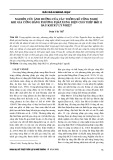
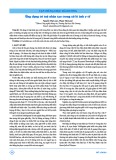
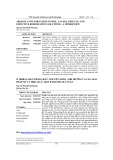

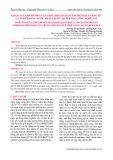

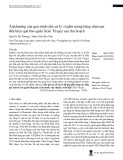
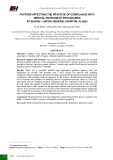

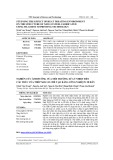
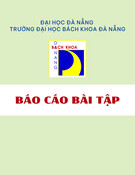


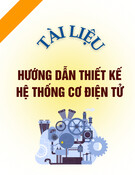


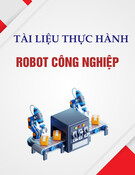




![Bài giảng Kỹ thuật robot [Mới nhất]](https://cdn.tailieu.vn/images/document/thumbnail/2025/20250715/vijiraiya/135x160/366_bai-giang-ky-thuat-robot.jpg)
![Câu hỏi ôn tập Cơ sở xử lý ảnh số [năm] chuẩn nhất](https://cdn.tailieu.vn/images/document/thumbnail/2025/20250710/kimphuong1001/135x160/84701752136985.jpg)

![Câu hỏi ôn tập Robot công nghiệp [năm hiện tại]](https://cdn.tailieu.vn/images/document/thumbnail/2025/20250702/kimphuong555/135x160/7711751422232.jpg)
